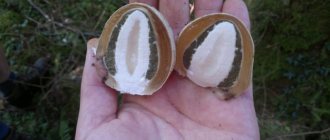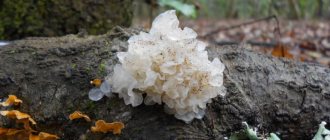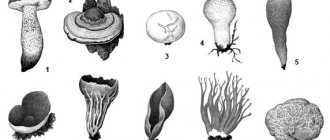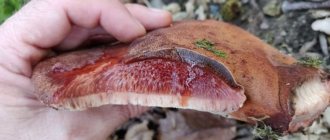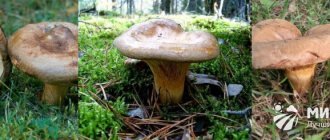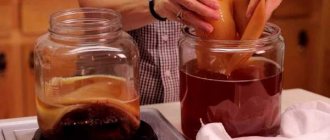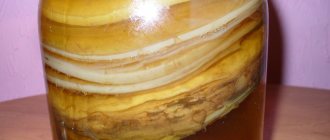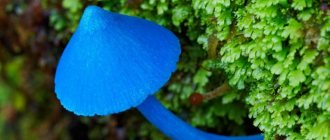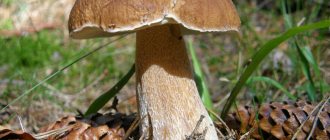Milk mushroom (Tibetan, kefir) is a symbiosis of more than ten different beneficial bacteria that convert milk into kefir.
The history of the milk mushroom is shrouded in mystery. It is believed that it was accidentally obtained by Tibetan monks who washed jugs for curdled milk not in a well, but in a lake, thus deciding to save clean water. There is an assumption that it was from the reservoir that special microorganisms got into the dishes for fermenting milk. Having entered into symbiosis with lactic acid bacteria, they became the “progenitors” of the most useful product of our time.
According to another legend, the milk mushroom, also known as kefir and Tibetan, was received by the Muslim tribes of the North Caucasus as a gift from the Prophet Muhammad. This happened more than 1500 years ago. For its beneficial properties, even then people called it a gift from Allah.
How the mushroom got to Europe is still unknown exactly. It is believed that it was imported by a traveler who was somehow able to trade the recipe with the monks. About 300 years ago, the mushroom appeared in Bulgaria, and at the beginning of the 19th century in Crimea, after which it spread throughout Russia.
Milk mushroom is a symbiosis of bacteria and microbes of the genus Zooloea. The drink, made from Tibetan mushrooms, is rich in vitamins, microelements, easily digestible proteins, lactobacilli and beneficial acids. Since ancient times, it has been used to improve immunity, treat diseases of the digestive system, and improve the health of the body.
Externally, the milk mushroom resembles cottage cheese or overcooked rice. It is round and spherical in shape. When favorable conditions are created, the mushroom grows quickly, reaching a diameter of 3-7 cm.
- Is it possible to grow Tibetan mushroom from scratch? Recipe
Chemical composition
The standard composition of Tibetan mushroom is due to the presence of lactobacilli, acetic acid bacteria and lactic yeast.
| Content | Amount, mg | Daily requirement, mg |
| Vitamin A" | 0,04- 0,12 | 1,5-2,0 |
| Thiamine | 0,1 | 1,4 |
| Riboflavin | 0,15- 0,30 | 1,5 |
| Pyridoxine | No more than 0.1 | 2,0 |
| Cobalamin | 0,5 | 3,0 |
| Niacin | 1,0 | 18 |
| Calcium | 120 | 800 |
| Iron | 0,1-2,0 | 8,0-12 |
| Iodine | 0,006 | 0,2 |
| Zinc | 0,40 | 15 |
Among other things, the composition is rich in folic acid, carbon dioxide, easily digestible proteins and polysaccharides, the benefits of which for the human body are invaluable.
Benefits of milk mushroom
Live milk mushroom is widely used today. The main beneficial properties of this culture are due to its chemical composition, so it is recommended to use it in the following cases:
- Choleretic agent;
- Antispasmodic;
- Reduction of benign tumors, represented by fibroids, myomas, polyps, prostate adenoma;
- Increased sexual activity;
- Rejuvenation of the body;
- Reducing the side effects of drugs, including broad-spectrum antibiotics;
- Decreased blood sugar levels;
- Improving overall tone;
- Getting rid of depression and insomnia;
- Getting rid of diaper rash and cracked skin.
Among other things, it is recommended to take an infusion of milk mushroom in order to normalize the intestinal microflora, prevent and treat most gastrointestinal diseases, including colitis, gastric and duodenal ulcers. This medicinal infusion is also very useful for various pulmonary diseases.
There have been cases of positive effects in inflammatory processes in the lungs, as well as malfunctions of the liver, kidneys and gall bladder. You can drink the infusion while following a weight loss diet, which is due to the ability of the Tibetan mushroom to very actively break down accumulated fats. The infusion can also be used as a highly effective cosmetic product, and milk mushroom can be used to prepare tonic and masks at home.
Positive properties
Milk fungus - benefits and harm. The fungus also has contraindications: let's look at everything in order and talk about its beneficial properties.
Benefits of kefir grains:
- Restores intestinal microflora. Kefir is useful for normalizing metabolism.
- Restoring microflora helps improve immunity.
- The product has a choleretic effect.
- The drink helps cleanse blood vessels, removes bad cholesterol, and fights free radicals.
The drink is useful for the prevention of serious diseases:
- atherosclerosis;
- hypertension;
- osteochondrosis;
- candidiasis;
- stomatitis and periodontal disease;
- diabetes mellitus;
- frequent respiratory diseases;
- cardiovascular pathologies;
- gastrointestinal diseases;
- liver and pancreas;
- kidney;
- tumor processes;
- all types of allergies.
In addition, the drink helps rejuvenate the body, increases libido and improves memory.
The product also has a wound healing effect:
- For boils and scratches, it is enough to put a napkin soaked in it on the affected area.
- For herpes, a compress with kefir relieves itching and burning.
- Foot baths made from fermented product are useful.
Attention: Kefir can be used to prepare dishes in the recipe of which regular kefir is used: cheesecakes, pies, salads and even for okroshka.
You can also use the drink for cosmetic purposes - for masks (the liquid left over from storing the fungus is especially suitable for these purposes). With bran or rolled oats you get an excellent peeling. You can even give the product to pets - their immunity increases and hair fragility decreases.
Possible harm and main contraindications for use
One should not draw conclusions that milk mushroom is a panacea for all diseases and has no contraindications for use. Harm from consuming the infusion of this culture may occur in the following cases:
- the presence of individual intolerance to any dairy and lactic acid foods;
- period of exacerbation and unstable remission of intestinal disorders;
- increased gas formation;
- a history of bronchial asthma;
- simultaneous use with any alcoholic beverages;
- simultaneous use with medicinal drugs;
- increased acidity and diarrhea;
- some fungal diseases;
- insulin-dependent forms of diabetes mellitus and simultaneous use with insulin.
Despite the fact that, in general, Tibetan milk mushroom can have a beneficial effect, its use should be preceded by a consultation with your doctor, which will allow you to receive all the necessary recommendations related to this remedy.
What it is?
Milk mushroom is a symbiotic group of microorganisms and bacteria used in kefir production technology. As a rule, the mushroom is characterized by a spherical shape and reaches a diameter of 7 cm.
The homeland of the substance is Tibet, and from there it spread to all corners of the world. For this reason, in addition to two names (milk and kefir), the mushroom also has a third - Tibetan. Thanks to its many beneficial properties, it is of great value in the field of medicine and cosmetology.
How to care for milk mushroom
Anyone can grow milk mushroom correctly, but, like all living things, this crop should be provided with competent, constant care, which consists of following the basic recommendations:
- Tibetan mushroom cannot be covered with a lid, since for growth and development the culture must “breathe”;
- You can’t keep the milk mushroom in a place that is too bright, where it can be negatively affected by direct sunlight;
- temperature conditions below 15-17°C often cause mold damage to the fungus;
- Tibetan mushroom should be stored and grown exclusively in three-liter glass jars, which are washed not with aggressive chemical detergents, but only with a solution based on baking soda;
- every day the milk mushroom must be carefully, but thoroughly washed and filled with a portion of fresh milk, which contributes to the active, full reproduction and growth of the fermented milk culture;
- If it is impossible to wash the mushroom for a couple of days, you should pour milk and water in a 1:1 ratio into a three-liter jar, after which the jar with the mushroom should be placed in a warm place.
During the first couple of weeks of consuming the milk mushroom infusion, there is a sharp increase in the activity of the intestinal tract, expressed by increased gas formation and increased frequency of stools. This process is natural. Patients with urolithiasis may notice the appearance of unpleasant sensations in the area of internal organs. After a couple of weeks of daily use, such symptoms disappear, after which a marked improvement in general condition and increased tone are observed.
Long-term storage
You can preserve kefir grains for the duration of the holidays - up to 3 months - without milk, in dry form. True, before it is re-preserved and used again to make a drink, it will take time to restore its qualities.
To dry zooglea:
- Leave the water to settle in advance so that all the chlorine evaporates. Then it is boiled and cooled.
- The starter is placed on a sieve and washed. Leave to almost completely remove moisture.
- A sieve with a fungus is placed on a jar - water will flow into it, covered with gauze. Place it in the kitchen in a place inaccessible to sunlight. But at the same time, the air flow must be stable to ensure ventilation.
- To protect from dust, cover with gauze folded in several layers.
- After 3-4 days, the curd lumps harden and dry out, they are transferred to a dry glass jar, and the neck is tightened with a thick cloth.
Attention! Dried starter should be stored at room temperature, protected from light. Heating or hypothermia is not allowed.
It will take 2-3 days to restore the kefir mushroom. It is poured with milk in a ratio of 1 tbsp. l. for 200 ml. After 12 hours, filter the infusion through a sieve, repeat pouring again, and so on 2-3 more times. As soon as the drink acquires its usual aroma, the starter is washed again. Only now it can be used to make kefir.
Rules of use
When consuming kefir grains, you must make it a rule to adhere to the following recommendations:
- the maximum volume of fermented milk drink consumed in the treatment of diseases should not exceed 0.6-0.7 liters per day;
- prevention involves using the drink in a volume of 250 ml per day;
- It is recommended to consume the kefir mushroom infusion at least an hour before bedtime.
Tibetan mushroom should not be combined with alcoholic beverages and alcohol-containing medications. For external use, it is recommended to make lotions or apply the infusion with your hands.
The effect of kefir grains on the body during diseases
The maximum therapeutic effect of the ingredient and products based on it manifests itself against the background of diseases. The benefits of milk mushroom for patients suffering from the following conditions will be immediate and obvious:
- Pancreatitis. Suppression of inflammatory processes can not only alleviate the condition of patients, but completely cure the disease. It is enough for an adult to consume 500-600 ml of the composition per day to quickly feel positive changes. But first, you should definitely consult a gastroenterologist on this issue.
- Gastritis. The ability of kefir grains to stabilize acidity in the stomach, destroy pathogenic microflora and suppress rotting processes gives very quick results. When carrying out drug therapy, these products also reduce the negative effects of chemicals on the body.
But if you have diabetes, it is better to avoid such products. It can neutralize the effect of medications, including insulin. This can cause sudden surges in blood glucose and critical conditions.
Main diseases of dairy culture
A healthy and properly grown mushroom is white in color and has the smell of fermented milk. The average size can vary between 0.1-30 mm. The crop should be cared for correctly. If there are errors in care or the purchase of low-quality mushrooms, the following diseases and growing problems may occur:
- the appearance of white mold or a sharp, rather unpleasant odor;
- the appearance of too large and hollow fractions inside;
- the appearance of mucous, clearly visible during the washing process;
- the appearance of a brown tint or dark color.
As a rule, such problems are associated with a large amount of fungus against the background of insufficient milk volume, incomplete ripening process and early removal of the fungus, the use of metal objects or too cold water in care.
a brief description of
Tibetan milk fungus for kefir fermentation is distinguished by the coexistence of different microorganisms, the relationship of which was formed as a result of active growth. During this time they adapted to living together. In addition, microorganisms behave as a single organism. The growth phase occurs quite quickly, but the structure and properties of the product itself are passed on from generation to generation.
Depending on the growing conditions, the fungus may have a white or yellowish tint.
Outwardly, it is very similar to ordinary cottage cheese. The taste of the fungus is sour and very specific. Separately, it is worth noting that taste indicators depend on lactic acid bacillus and yeast, which are considered the main microflora of the fungus. At the initial stage of development, the product consists of small grains, the diameter of which can reach 6 mm. At the initial stage of division, the diameter can increase to 40 and even 50 mm.
Growing from scratch
Growing Tibetan milk mushroom yourself from scratch is not too difficult. However, you should definitely adhere to the following recommendations:
- Pour a couple of tablespoons of the dairy product with milk and put the jar with the culture in a dark place, where the process of active ripening takes place for about a day;
- Strain the kefir liquid obtained as a result of fermentation using a sieve and a wooden spoon;
- thoroughly, but very carefully, rinse the mushroom with water at room temperature, carefully removing pieces of mucus and remaining fragments of kefir;
- transfer the mushroom to a clean and dry three-liter jar, then pour in the milk;
- remove all floating fractions.
To prevent overheating, cover the jar of mushroom with gauze and store it at a comfortable room temperature. Gauze will also prevent small debris and dust particles from getting into the infusion.
Preparing yogurt
Milk fungi for homemade kefir are suitable for making yogurt. Milk mushroom yogurt is prepared in the same way as kefir, but it is recommended to keep the yogurt at a temperature of about 38 degrees Celsius, which will allow the product to thicken.
If the density is insufficient, you can add 1 tablespoon of milk powder for every 250 ml of raw materials. In addition, yogurt recipes involve the use of various additives: berries, jams, preserves. They should be added to yogurt to taste, immediately before use.
Reviews from doctors
In general, the reviews of most doctors about the benefits of the Tibetan mushroom are quite unanimous and characterize this culture as very effective in the treatment and prevention of a number of diseases. According to people who consume kefir mushrooms on the recommendation of doctors, this drink has several advantages over store-bought fermented milk drinks, including having a less sour and harsh taste.
However, all medical professionals agree that self-medication with kefir grains is extremely dangerous, especially in the presence of serious pathology or severe somatic diseases. That is why it is not recommended to use fermented milk infusion for a long time without breaks, and you should also consult a doctor in advance, which will avoid many negative consequences.
